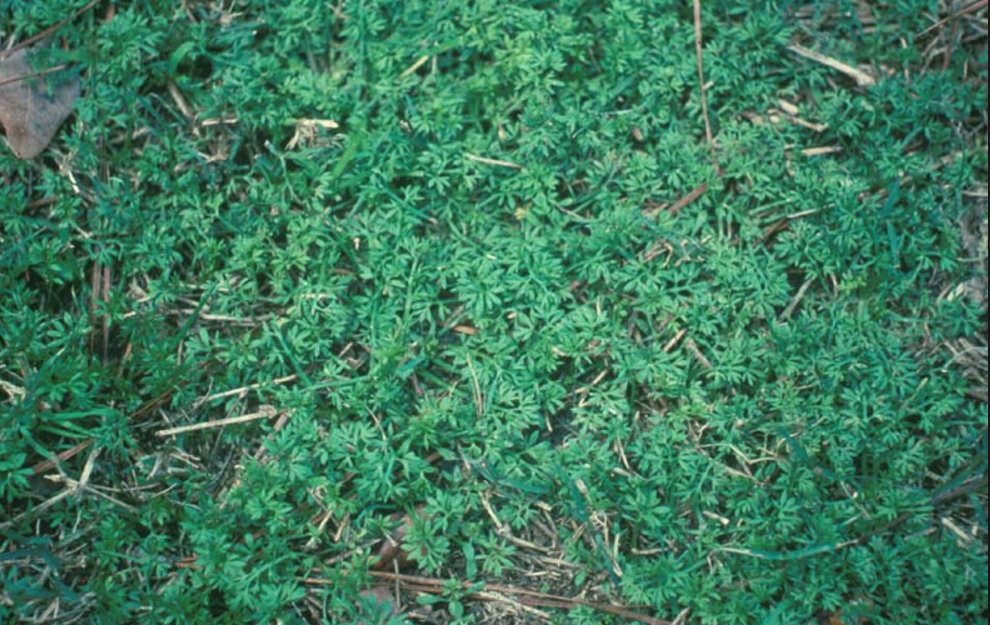What is that weed: Lawn burrweed
 This time of the year is always a challenge for the gardener. Our lawns are idle with most of the grasses dormant. Sporadic ryegrass blades might be greening up and need some touch-up mowing but in general our gardens are just as we are: cold and grumpy waiting for the temperatures to raise. This year our knock-out roses had an unexpected flowering last week: The “Nacogdoches” yellow roses bloomed and greened up as a reminder to me that springs is just few weeks away. For some residents in the county the carpet burweed or lawn burweed (Soliva spp.), a cool season annual introduced from South America, has become a nuisance on golf courses, athletic fields, parks and lawns. According to Texas A&M AgriLife Extension the lawn burrweed becomes a real nuisance when the seed matures in the spring because the sharply pointed spines on the seed can easily pierce the skin. Burweed becomes a deterrent to the use of athletic fields, parks and playgrounds in the spring when the seed mature. On golf courses, burrweed invades even the most closely mowed putting greens as well as fairways, tees and roughs. Burweed is a small, low-growing annual plant. In an unmowed site, it only reaches 2 inches in height and the individual plants may spread out to about 6 inches in diameter. Leaves are pinnately divided giving the plant a feathery appearance. The seed enclosures are flattened, callous structures terminating in teeth on spines. Burweed emerges in early fall and matures in the spring. The vegetative part of the plant dries up in May and the seeds remain to germinate the next fall. Populations of the weed may become so high that plants cover the ground like a carpet-thus, the name “carpet burweed.” Where grassy weeds such as annual bluegrass are eliminated by the use of preemerge herbicides, populations of burweed increase dramatically in following years.Like most broadleaf weeds, burweed is easily controlled in the seedling stage with hormone-type herbicides. Products containing 2,4-D, MCPP and dicamba will control burweed in the seedling stage. Preemerge herbicides are generally not effective for burweed control. In fact, burweed populations increase where preemerge herbicides reduce the competition. Products based on isoxaben are label to use as pre-emergent herbicide for Soliva spp. For more information on this or any other agricultural topic please contact the Hopkins County Extension Office at 903-885-3443 or email me at [email protected].
This time of the year is always a challenge for the gardener. Our lawns are idle with most of the grasses dormant. Sporadic ryegrass blades might be greening up and need some touch-up mowing but in general our gardens are just as we are: cold and grumpy waiting for the temperatures to raise. This year our knock-out roses had an unexpected flowering last week: The “Nacogdoches” yellow roses bloomed and greened up as a reminder to me that springs is just few weeks away. For some residents in the county the carpet burweed or lawn burweed (Soliva spp.), a cool season annual introduced from South America, has become a nuisance on golf courses, athletic fields, parks and lawns. According to Texas A&M AgriLife Extension the lawn burrweed becomes a real nuisance when the seed matures in the spring because the sharply pointed spines on the seed can easily pierce the skin. Burweed becomes a deterrent to the use of athletic fields, parks and playgrounds in the spring when the seed mature. On golf courses, burrweed invades even the most closely mowed putting greens as well as fairways, tees and roughs. Burweed is a small, low-growing annual plant. In an unmowed site, it only reaches 2 inches in height and the individual plants may spread out to about 6 inches in diameter. Leaves are pinnately divided giving the plant a feathery appearance. The seed enclosures are flattened, callous structures terminating in teeth on spines. Burweed emerges in early fall and matures in the spring. The vegetative part of the plant dries up in May and the seeds remain to germinate the next fall. Populations of the weed may become so high that plants cover the ground like a carpet-thus, the name “carpet burweed.” Where grassy weeds such as annual bluegrass are eliminated by the use of preemerge herbicides, populations of burweed increase dramatically in following years.Like most broadleaf weeds, burweed is easily controlled in the seedling stage with hormone-type herbicides. Products containing 2,4-D, MCPP and dicamba will control burweed in the seedling stage. Preemerge herbicides are generally not effective for burweed control. In fact, burweed populations increase where preemerge herbicides reduce the competition. Products based on isoxaben are label to use as pre-emergent herbicide for Soliva spp. For more information on this or any other agricultural topic please contact the Hopkins County Extension Office at 903-885-3443 or email me at [email protected].

Mario Villarino DVM, Ph.D.
Hopkins County Extension Agent for Ag and NR
1200B Houston Street
Sulphur Springs, Texas 75482
903-885-3443







